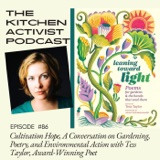
THE KITCHEN ACTIVIST
Florencia Ramirez
Podcast
Episodes
Listen, download, subscribe
How Skipping Food and Products with Palm Oil Saves Water
• 11 minEpisode Summary Recently I sent my teenage son, Joaquin to pick up flour tortillas for dinner. He handed me the package and said without prompting, this is the only brand that didn’t have palm oil. It has become second nature to look for this ingredient for all of us in the family. But it hasn’t always been the case. I didn’t connect the dots between palm oil, and global water systems until I did the research for the chocolate chapter in my book Eat Less Water. When I was immersed in the research for cacao farming it brought me to tears. Palm plantations are devastating not only to water systems, but to groups of people who are displaced, to animals now facing extinction, and to our global climate. Palm oil is the most popular vegetable oil on the planet because it's cheap. The cheap oil can be found in over half the items found in any grocery store from chocolate to toothpaste. The true cost of the popular cheap oil is best explained through the story of peatlands and forests. If you don't know what peatlands are I didn't know until I did the research for my chapter. Peatlands are essentially layers of soggy plant debris. They act as freshwater reservoirs like wetlands. Formed over 10,000 years, these layers of plant material can reach depths of 70 feet. These saturated land filters the water for animals and humans living downstream and are critical in regulating global climate. Peatlands hold 30% of the world's carbon. More than all the forests combined. Over the ages, peatlands absorbed 1.2 trillion, tons of carbon dioxide. And to get a sense of what that looks like. It is the amount emitted from 34,000 coal plants in a year. But as I explain in this episode, illegal fires are downing these virgin forests draining the peatlands of freshwater to make way for the orderly rows of palm trees that now engulf the tropic landscape. This is especially true in Indonesia, the largest producer of palm. The 18,000 islands that comprise this nation are lush in biodiversity and host to one of the most extensive peatlands in the world. But 2 million palm plantations grow on former peatlands in Indonesia and the number grows as the palm oil keeps flowing to our favorite food brands. The damage to the peatlands to clear the terrain for palm is irreversible. When peatlands are drained and burned, carbon, the leading contributor to climate change is released into the atmosphere. Peatlands are necessary, not cheap palm oil. But as I explain in this episode, there are actions we can take during our next trip to the store to turn the tide. Take a listen and send me any questions or ideas you implement in your kitchen to Eat Less Water by replying to this email. When we merge our influence we can change the world one meal at a time. Be resplendent, Florencia Links and resources: Click here for the free How to Eat Less Water CONDIMENT STORAGE TABLE. It is a printable list of popular condiments that belong in the pantry and those in the refrigerator that can be hung in your kitchen for easy reference. Download the TEN TIPS to EAT LESS WATER SUMMER PARTY PLANNING GUIDE for all the tips, steps, and info on celebrating like a kitchen activist with your friends and family. Find gifts designed to serve well-being at the Eat Less Water Shop. Get a copy of the EAT LESS WATER book. Reach me at info@eatlesswater.com
THE KITCHEN ACTIVIST RSS Feed







